1. Sook CK. Current status of chronic obstructive pulmonary disease (COPD) in the Republic of Korea. Public Health Wkly Rep. 2021; 14(16):943–951.
2. Viegi G, Maio S, Fasola S, Baldacci S. Global burden of chronic respiratory diseases. J Aerosol Med Pulm Drug Deliv. 2020; 33(4):171–177. PMID:
32423274.
3. Leem AY, Park B, Kim YS, Chang J, Won S, Jung JY. Longitudinal decline in lung function: a community-based cohort study in Korea. Sci Rep. 2019; 9(1):13614. PMID:
31541126.
4. Rennard SI, Vestbo J. COPD: the dangerous underestimate of 15%. Lancet. 2006; 367(9518):1216–1219. PMID:
16631861.
5. Joshi P, Kim WJ, Lee SA. The effect of dietary antioxidant on the COPD risk: the community-based KoGES (Ansan-Anseong) cohort. Int J Chron Obstruct Pulmon Dis. 2015; 10:2159–2168. PMID:
26504380.
6. Steinemann N, Grize L, Pons M, Rothe T, Stolz D, Turk A, et al. Associations between dietary patterns and post-bronchodilation lung function in the SAPALDIA cohort. Respiration. 2018; 95(6):454–463. PMID:
29730665.
7. Shin MK, Kwak SH, Park Y, Jung JY, Kim YS, Kang YA. Association between dietary patterns and chronic obstructive pulmonary disease in Korean adults: the Korean genome and epidemiology study. Nutrients. 2021; 13(12):4348. PMID:
34959900.
8. Nettleton JA, Follis JL, Schabath MB. Coffee intake, smoking, and pulmonary function in the atherosclerosis risk in communities study. Am J Epidemiol. 2009; 169(12):1445–1453. PMID:
19372215.
9. Min JE, Huh DA, Moon KW. The joint effects of some beverages intake and smoking on chronic obstructive pulmonary disease in Korean adults: data analysis of the Korea national health and nutrition examination survey (KNHANES), 2008–2015. Int J Environ Res Public Health. 2020; 17(7):2611. PMID:
32290216.
10. Kim Y, Han BG. KoGES group. Cohort profile: the Korean genome and epidemiology study (KoGES) consortium. Int J Epidemiol. 2017; 46(2):e20. PMID:
27085081.
11. Ahn Y, Kwon E, Shim JE, Park MK, Joo Y, Kimm K, et al. Validation and reproducibility of food frequency questionnaire for Korean genome epidemiologic study. Eur J Clin Nutr. 2007; 61(12):1435–1441. PMID:
17299477.
12. Kim J, Kim Y, Ahn YO, Paik HY, Ahn Y, Tokudome Y, et al. Development of a food frequency questionnaire in Koreans. Asia Pac J Clin Nutr. 2003; 12(3):243–250. PMID:
14505984.
13. Ahn Y, Park YJ, Park SJ, Min H, Kwak HK, Oh KS, et al. Dietary patterns and prevalence odds ratio in middle-aged adults of rural and mid-size city in Korean genome epidemiology study. Korean J Nutr. 2007; 40(3):259–269.
14. Kim J, Jo I. Grains, vegetables, and fish dietary pattern is inversely associated with the risk of metabolic syndrome in South Korean adults. J Am Diet Assoc. 2011; 111(8):1141–1149. PMID:
21802559.
15. Korean Nutrition Society. 2015 Dietary Reference Intakes for Koreans (KDRIs). Seoul, Korea: Korean Nutrition Society;2015.
16. Song S, Kim J, Kim J. Gender differences in the association between dietary pattern and the incidence of hypertension in middle-aged and older adults. Nutrients. 2018; 10(2):252. PMID:
29473892.
17. Lee JY, Jun NR, Yoon D, Shin C, Baik I. Association between dietary patterns in the remote past and telomere length. Eur J Clin Nutr. 2015; 69(9):1048–1052. PMID:
25872911.
18. Shin MK, Kim YS, Kim JH, Kim SH, Kim Y. Dietary patterns and their associations with the diet quality index-international (DQI-I) in Korean women with gestational diabetes mellitus. Clin Nutr Res. 2015; 4(4):216–224. PMID:
26566516.
19. Korea Disease Control and Prevention Agency. Ansan Community-Based Cohortv Study. Cheongju, Korea: Korea Disease Control and Prevention Agency;2020.
20. Kim AH, Seo IH, Lee HS, Lee YJ. Long-term adverse effects of cigarette smoking on the incidence risk of metabolic syndrome with a dose-response relationship: longitudinal findings of the Korean genome and epidemiology study over 12 years. Endocr Pract. 2022; 28(6):603–609. PMID:
35288334.
21. American Thoracic Society. Standardization of spirometry, 1994 update. Am J Respir Crit Care Med. 1995; 152(3):1107–1136. PMID:
7663792.
22. Vestbo J, Hurd SS, Agustí AG, Jones PW, Vogelmeier C, Anzueto A, et al. Global strategy for the diagnosis, management, and prevention of chronic obstructive pulmonary disease: GOLD executive summary. Am J Respir Crit Care Med. 2013; 187(4):347–365. PMID:
22878278.
23. Kim SH, Lee H, Joo H, Choi H, Sim YS, Rhee CK, et al. Risk of rapid lung function decline in young adults with chronic obstructive pulmonary disease: a community-based prospective cohort study. J Korean Med Sci. 2023; 38(1):e3. PMID:
36593687.
24. Kim SA, Shin S. The association between coffee consumption pattern and prevalence of metabolic syndrome in Korean adults. Nutrients. 2019; 11(12):2992. PMID:
31817748.
25. Kim AN, Youn J, Cho HJ, Jin T, Shin S, Lee JE. Comparison of 24-hour recalls with a food frequency questionnaire in assessing coffee consumption: the health examinees (HEXA) study. Korean J Community Nutr. 2020; 25(1):48–60.
26. Kim D, Kim J. Dairy consumption is associated with a lower incidence of the metabolic syndrome in middle-aged and older Korean adults: the Korean genome and epidemiology study (KoGES). Br J Nutr. 2017; 117(1):148–160. PMID:
28098053.
27. Ainsworth BE, Haskell WL, Whitt MC, Irwin ML, Swartz AM, Strath SJ, et al. Compendium of physical activities: an update of activity codes and MET intensities. Med Sci Sports Exerc. 2000; 32(9):Suppl. S498–S504. PMID:
10993420.
28. Varraso R, Fung TT, Barr RG, Hu FB, Willett W, Camargo CA Jr. Prospective study of dietary patterns and chronic obstructive pulmonary disease among US women. Am J Clin Nutr. 2007; 86(2):488–495. PMID:
17684223.
29. Varraso R, Fung TT, Hu FB, Willett W, Camargo CA. Prospective study of dietary patterns and chronic obstructive pulmonary disease among US men. Thorax. 2007; 62(9):786–791. PMID:
17504819.
30. Shaheen SO, Jameson KA, Syddall HE, Aihie Sayer A, Dennison EM, Cooper C, et al. The relationship of dietary patterns with adult lung function and COPD. Eur Respir J. 2010; 36(2):277–284. PMID:
20075056.
31. McKeever TM, Lewis SA, Cassano PA, Ocké M, Burney P, Britton J, et al. Patterns of dietary intake and relation to respiratory disease, forced expiratory volume in 1 s, and decline in 5-y forced expiratory volume. Am J Clin Nutr. 2010; 92(2):408–415. PMID:
20554789.
32. Je Y, Jeong S, Park T. Coffee consumption patterns in Korean adults: the Korean national health and nutrition examination survey (2001–2011). Asia Pac J Clin Nutr. 2014; 23(4):691–702. PMID:
25516328.
33. Mamillapalli C, Tentu R, Jain NK, Bhandari R. COPD and type 2 diabetes. Curr Respir Med Rev. 2019; 15(2):112–119.
34. Lee J, Kim HY, Kim J. Coffee consumption and the risk of obesity in Korean women. Nutrients. 2017; 9(12):1340. PMID:
29292767.
35. Kim HJ, Cho S, Jacobs DR Jr, Park K. Instant coffee consumption may be associated with higher risk of metabolic syndrome in Korean adults. Diabetes Res Clin Pract. 2014; 106(1):145–153. PMID:
25112922.
36. Park HS, Lee JS. Association with obesity and abdominal obesity according to the kind and amount of coffee intake in Korean adults: 2013~ 2016 Korea national health and nutrition examination survey. J Nutr Health. 2019; 52(4):369–382.
37. Walter RE, Beiser A, Givelber RJ, O’Connor GT, Gottlieb DJ. Association between glycemic state and lung function: the Framingham heart study. Am J Respir Crit Care Med. 2003; 167(6):911–916. PMID:
12623860.
38. Esposito K, Nappo F, Marfella R, Giugliano G, Giugliano F, Ciotola M, et al. Inflammatory cytokine concentrations are acutely increased by hyperglycemia in humans: role of oxidative stress. Circulation. 2002; 106(16):2067–2072. PMID:
12379575.
39. Forgiarini LA Jr, Kretzmann NA, Porawski M, Dias AS, Marroni NA. Experimental diabetes mellitus: oxidative stress and changes in lung structure. J Bras Pneumol. 2009; 35(8):788–791. PMID:
19750332.
40. Trends in prevalence of current cigarette smoking, 2010–2020. Public Health Wkly Rep. 2022; 12(21):1485–1486.
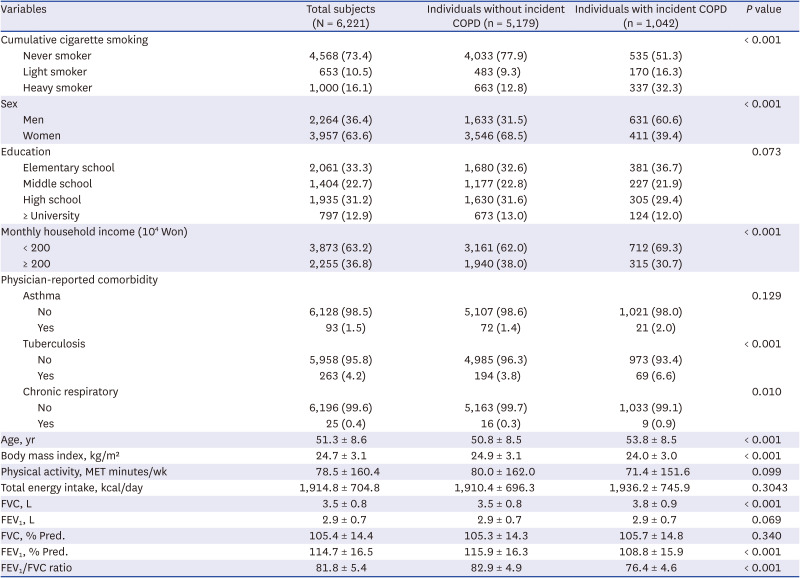
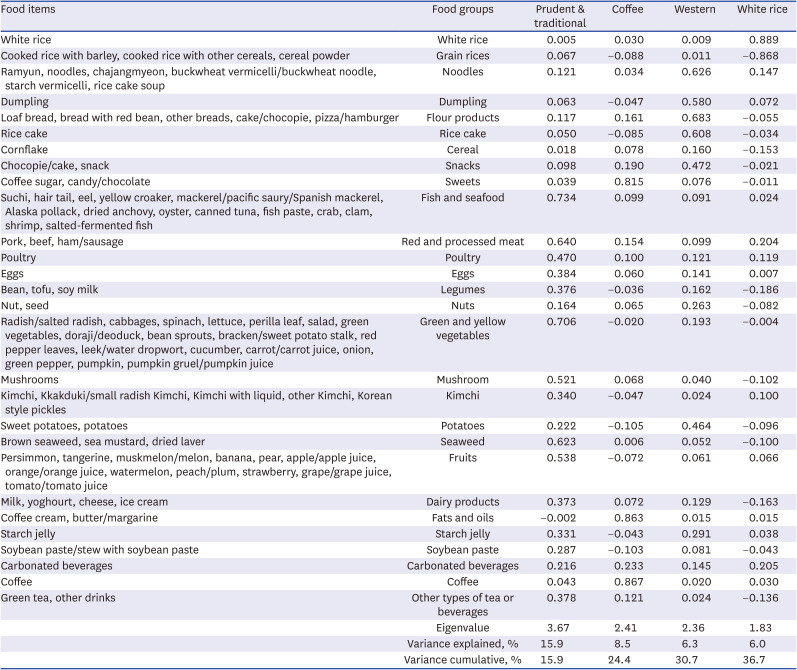
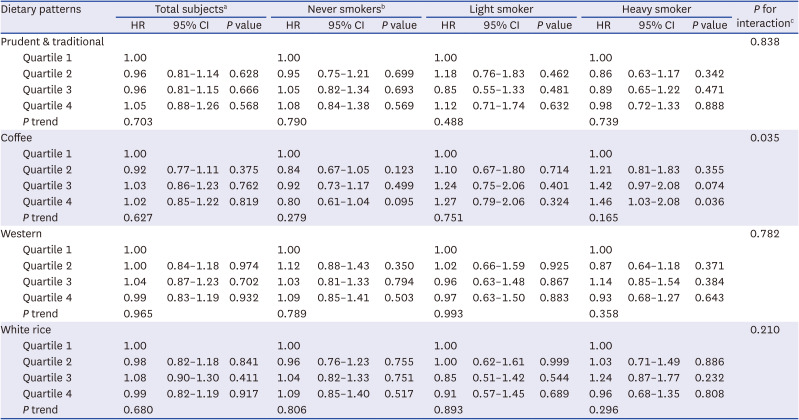
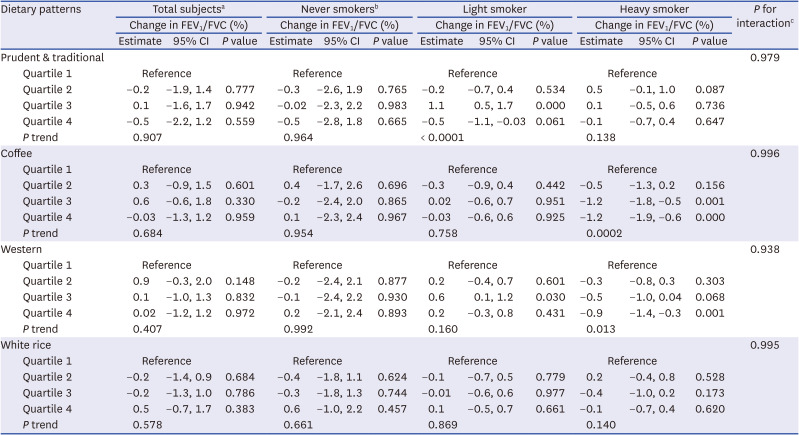
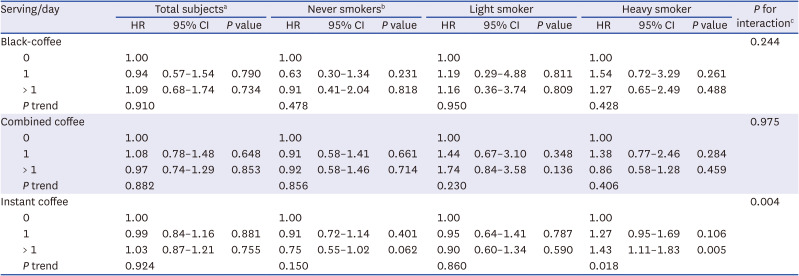




 PDF
PDF Citation
Citation Print
Print



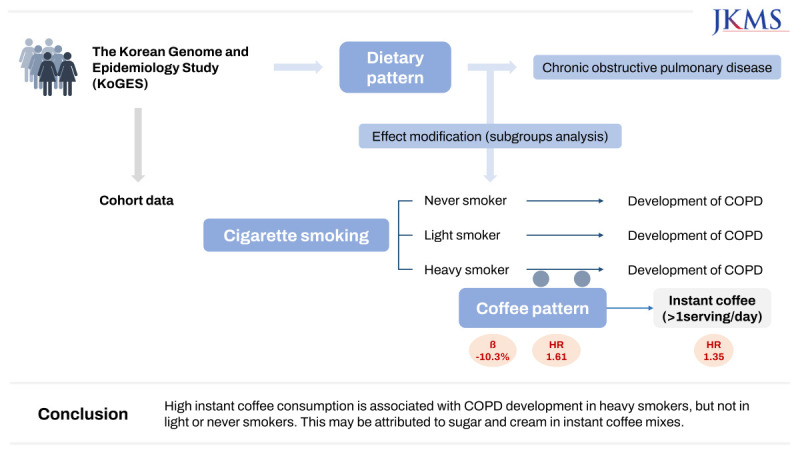
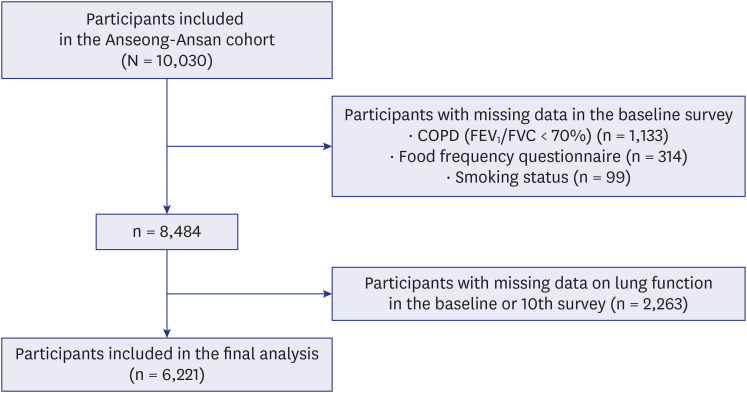
 XML Download
XML Download